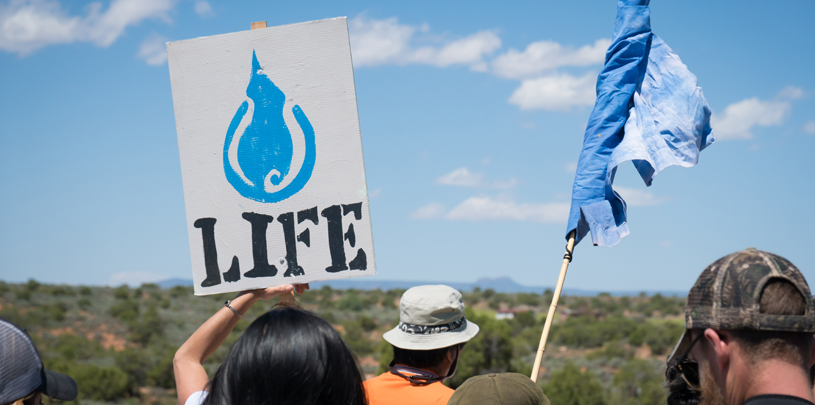
 by Amber Reimondo, Energy Director
by Amber Reimondo, Energy Director
The nation’s last operating conventional uranium mill’s bid to renew its operating permits and accept radioactive sludge from a toxic site in Oklahoma is creating quite a stir in Utah, with a public comment period set to close July 31, 2017.
The White Mesa uranium mill is located near the small Ute Mountain Ute tribal community of White Mesa, whose residents live down-gradient and often downwind of the mill, and many of whom oppose the permit renewal. Last month, the Salt Lake Tribune weighed in, editorializing that the “Rules for White Mesa uranium mill are not confidence inspiring.” The mill is a destination for uranium ore mined around the Grand Canyon and for toxic and radioactive wastes from across the country. “[W]hat reason is there to have any faith that either the company or the state really cares about how the plant is operated or what threats it might pose to the surrounding area?” the Tribune asks.
Mark Chalmers, the chief operating officer of Energy Fuels Resources, the American subsidiary of the Canadian company that owns and operates the mill as well as several uranium mines around the Grand Canyon, shot back in an editorial of his own, claiming the “White Mesa Mill is regulated and environmentally safe.”
Mr. Chalmers insists that his company, Energy Fuels, runs the White Mesa uranium mill like a boy scout. So why use corporate jargon to hide the ball? “There is no evidence,” Mr. Chalmers says, “that groundwater has been impacted by the mill’s tailings cells.” But is groundwater beneath the mill contaminated? You bet it is.

White Mesa uranium mill as seen from the air. Photo by Bruce Gordon, EcoFlight.
Energy Fuels, taking advantage of the inherent complexity of groundwater science, embraces the dearth of non-technical public information to broadly claim there is “no evidence” that the cells are to blame and to imply that the case has been closed. But at least from the Tribe’s perspective, that’s still up for debate.
The mill complies “with every applicable law, rule and regulation,” Mr. Chalmers asserts. Since when? Recently, the mill’s waste pits have been emitting radon in violation of federal air-quality standards. And the alternate-feed business, per Mr. Chalmers, amounts to “recycling unusable materials into a clean energy.” But does the mill recycle everything? Nowhere close. The leftover waste — radioactive, toxic, and otherwise — is buried forever in acres and acres of space next to the mill.
So look, Energy Fuels may not be slapdash about public health or environmental safety. But if the company wants people to trust that it has a no-nonsense approach to the standards governing the mill, it should start by telling a no-nonsense story about the mill.
A few days after Mr. Chalmers’ op-ed, Ute Mountain Ute tribal member and community activist Yolanda Badback, who lives in White Mesa, wrote in to ask regulators to “Put White Mesa’s children ahead of uranium mill.”
Badback explains: “When the mill's running, it smells like chemicals at my house. We take in radiation from the mill, me, my kids, my mom, my family, my people. The trucks that come and go from the mill are dangerous, especially for my kids and other kids in White Mesa who ride the school bus by the mill. The mill was built on top of burial grounds and contaminates the bones of my ancestors.”

Concerned community members in White Mesa. Photo by Corey Robinson.
Badback urges Utah regulators to take action to protect the White Mesa community. Between now and July 31, you can do the same.
The Utah Division of Waste Management and Radiation Control will accept public comments by email and postal mail until July 31, 2017.
Submit comments by mail:
More than 275,000 pounds of radioactive materials imported from the Japan Atomic Energy Agency headed to Utah's White Mesa Mill.
Read MoreWhite Mesa Ute community leaders testify in Washington D.C. about how Utah's White Mesa uranium mill, near Bears Ears, affects their lives.
Read More"We want to have healthy lives. We want to have access to clean water," says Chairman Manuel Heart.
Read More